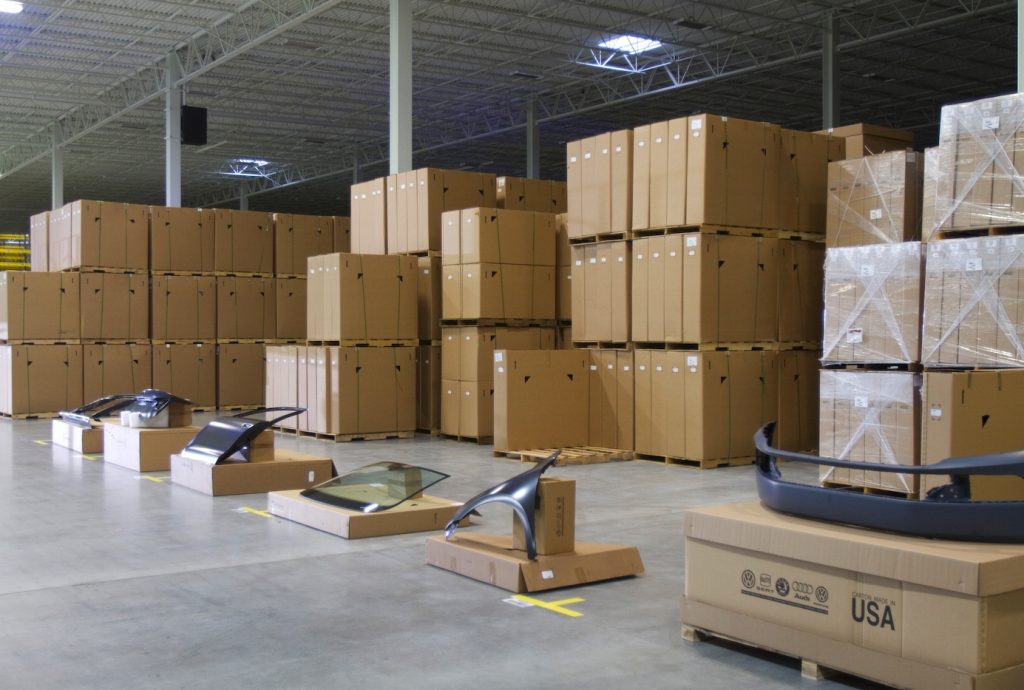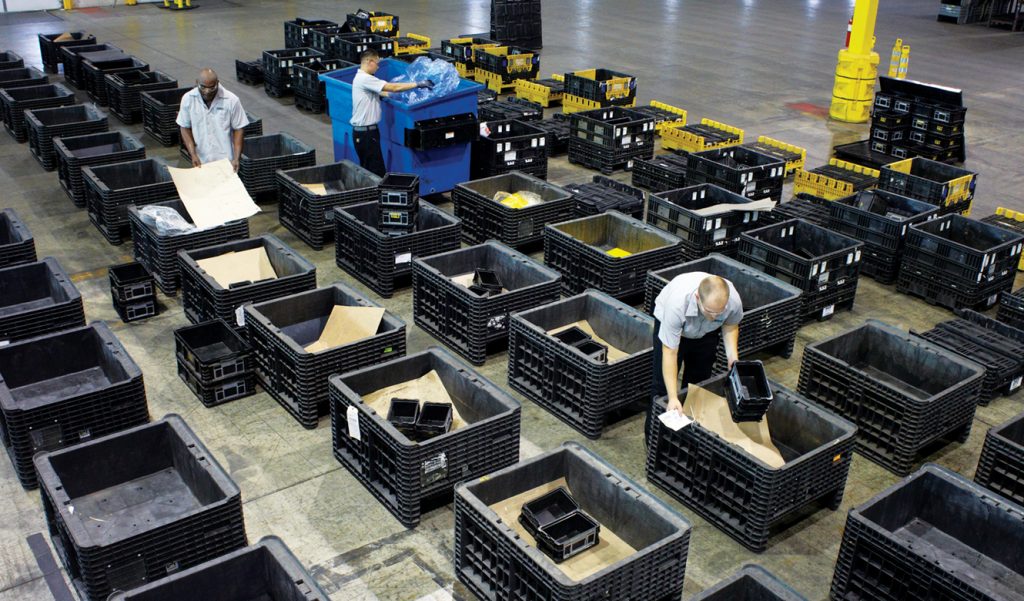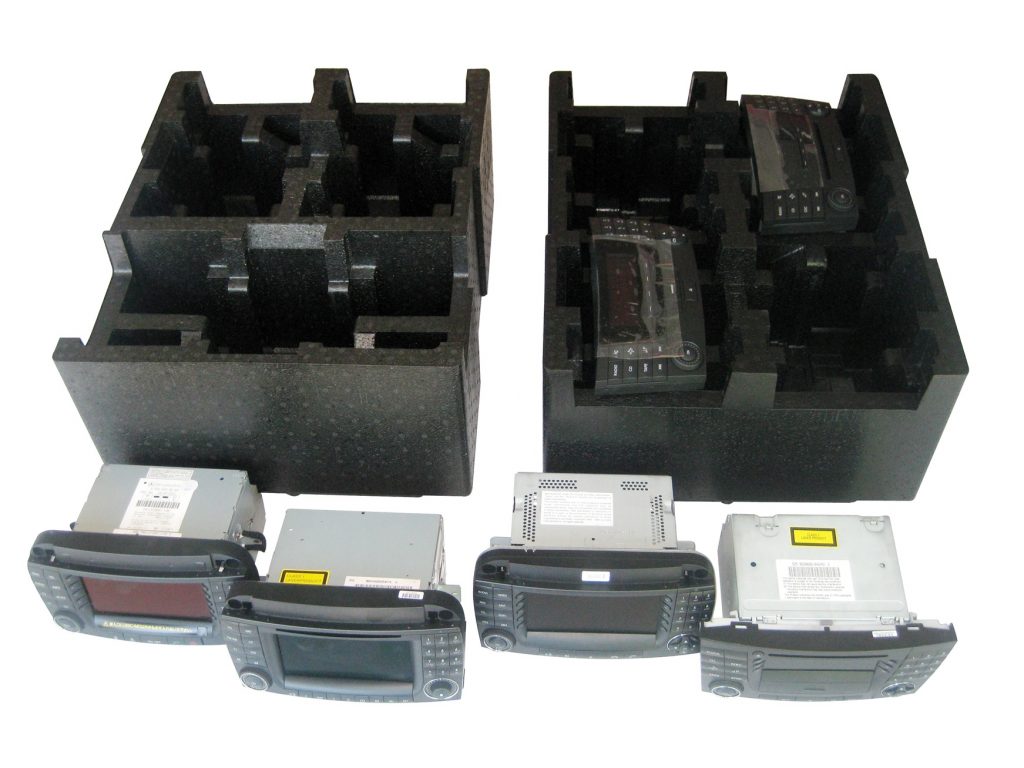 Close analysis of damage rates, transport efficiency and handling procedures are necessary to meet the complex and diverse packaging needs of aftermarket distribution
Close analysis of damage rates, transport efficiency and handling procedures are necessary to meet the complex and diverse packaging needs of aftermarket distribution
Packaging for spare parts requires a multitude of different materials and equipment depending not only on the type of part being moved, but where it is in the supply chain. Bulk shipments of parts sent from suppliers to a carmaker’s master depot or source warehouse, for example, require a very different approach to smaller shipments sent to distribution centres, and especially to individual or specific customer orders sent to dealers. While carmakers and packaging providers seek to use returnable equipment where possible, retail demands can make it more difficult to use such packaging consistently.
Carmakers must therefore develop different methods that are suitable for transport and for storage, especially as some slow-moving parts may be held in inventory for long periods of time and need to be protected from rust or contamination. However, individually packed parts take up valuable inventory space, while for transport it is important to have packaging that can stack well and remain protected while moving. Thus, effective systems to manage the transhipment of parts between different packaging are vital.
All factors have to be considered carefully before deciding upon a packaging solution for spare parts, says Scott Huddas, client solutions and strategy manager at packaging specialist Surgere. A part’s shipping frequency and seasonal demand may inform how many will be stored in a box. Sensitive parts may need added protection, while placing parts with different surface classifications into the same container requires detailed planning. Parts must also be delivered appropriately for dealers to store or install. “Efficient shipping is of no use if the container does not comply with restrictions at the delivery or ‘use point’, or if there is damage to the product. We gain a systems view of the lifecycle and determine the best possible scenarios,” says Huddas.
Michael Wappler, manager of client solutions development at Surgere, emphasises the need for a data-driven approach to packaging selection. “The ability to acquire data allows us to use trend analyses including fleet velocity and utilisation as well as enterprise visibility of packaging fleets, meaning it is possible to optimise the packaging supply chain from new perspectives – from how and when a container is filled to the condition and time of receipt,” he says.

In many cases, reusable containers help to reduce expendable packaging material and increase overall strength and stacking capability, reducing damage and claims in the process. The biggest advantage is the ability to compile multiple SKUs (stock keeping units) within the same reusable container. For example, Scott Huddas recommends returnable packaging systems at parts centres; with parts stored in bulk in returnable containers within the warehouse, companies can use a pick system to pull the parts into the containers. “This system would provide all the benefits of a reusable container system, while also reducing inventory resources,” he says.
Getting to the dealer one way or another
However, conditions for moving parts to dealers may require other solutions. Mike Allen, senior parts manager for logistics at Nissan North America, says that the OEM’s service parts packaging materials include pressure-treated wooden pallets, returnable steel dedicated delivery system (DDS) cages, polymer totes, corrugated boxes, corrugated wrap, and poly bags. The reusable portion is the ‘over-packaging’, such as closet-sized DDS cages, which it delivers to the dealerships. In the cages, Nissan places small totes that may contain nuts, bolts, key fobs, or thermostats that are individually wrapped.
At Nissan, individual packaging specifications for all parts sourced in the US are set at the national level and maintained throughout the parts distribution network. However, parts may be over-packed differently at parts distribution centres (PDCs), depending on the mode of transport to dealers and the variety of parts.
For individual parts bound for dealerships, Nissan uses only expendable packaging. These parts are typically dictated by logistics methods and the dealers’ quality expectations. In contrast, high-volume bulk shipments from suppliers to Nissan warehouses are sent mainly in returnable packaging. “Our objectives include properly cubing the pallet to double stack in the trailer, and making sure that pallet specs comply with PDC storage requirements,” explains Allen.
At Volkswagen Group of America, Aaron Rudy, manager of supplier integration and total quality management, oversees packaging from suppliers to parts depots, and from depots to dealerships. Like Nissan, Volkswagen uses both expendable and returnable packaging for its dealer-bound spare parts shipments, with materials including corrugated boxes, foam, bubble wrap, metal cages, and plastic foldable totes.
 Volkswagen Group has seen reduced damage claims since it began packing Passat fenders from Mexico and Germany in L-shaped boxes
Volkswagen Group has seen reduced damage claims since it began packing Passat fenders from Mexico and Germany in L-shaped boxesVolkswagen Group’s returnable packaging in the US is barcoded and labelled: 87% is in DDS closed loops and 13% ships by air freight or as less than truckload (LTL).
An oversized issue
Large parts are difficult to ship to dealerships; they are often ill-suited to standard returnable systems because they do not fit in totes or cages and thus need to be packed individually. Nissan’s Mike Allen says that such large spare parts are also more susceptible to damage across shipping modes. For example, road carriers tend to use larger parts as stacking platforms, increasing the likelihood of damage. “Nissan uses best practice initiatives such as monthly performance reviews, visual reminders such as labels, and supervisor oversight in order to increase awareness with packaging handlers, carriers, and dealers,” Allen says.
Nissan North America has introduced retention and suspension service packs that relieve stress and reduce the stacking load placed on a part.
For large parts, packaging may need to be designed especially for a part number or commodity. Nissan packs parts such as windshield glass suspended in reinforced corrugated boxes, for example. “We also changed the tail lamps commodity from corrugate to a suspension type of corrugate. As a result, the damage rate dropped by 30% over 18 months,” Allen adds. “We had previously used foam or corrugate inserts. Now, we suspend the parts with foam, corrugate, and two-way tape. This enables minimal touching of the box and provides air between the box and parts.”
Allen adds that poly air bags are not good for large parts as they cause damage.
Nissan used to box its bumper fascia, which caused issues with space and cost. It then moved to poly-woven materials two years ago. “Now, we are using a woven reinforced bag fascia, and damage rates have dropped by two-and-a-half times. Suspension and retention packaging is still being rolled out with new models,” he says.
Allen adds that as spare parts materials become lighter to improve fuel efficiency, several methods used to block and brace parts in individual packaging have become less effective. Non-painted textured bumper fascias, for example, are now more susceptible to damage while handling.
For Volkswagen, if the part is too large to ship in multiple quantities, such as with hoods, side panels, or windshield glass, it also uses standalone packaging. Aaron Rudy says Volkswagen of America is now collaborating on sheet metal packaging with the OEM’s spare parts distribution centre in Kassel, Germany (see feature on Kassel). “Packaging sheet metal is always an issue due to the nature of the part. In the past, we would receive one large box with ten hoods and then repackage them singly for dealership delivery,” he says.
One area of focus for Volkswagen is to drive down damage claims for parts such as fenders and liftgates from Germany and Mexico. “We are changing the packaging design from bulk pack to retail pack with one part per container. For shipping by ocean to our regional distribution centre in New Jersey, we use an all-corrugate die cut that floats the part,” Rudy says.
Volkswagen also used to package fenders in paper bags in Germany, which would require repacking in the US. Rudy says the bags meant people could not see into the sealed box it was using, so damage was missed. “In late 2014 and early 2015, we stopped using the bag and we now use an L-shaped box for the Passat fenders from Mexico and Germany. This has led to a reduction in claims,” he says.
 One area of focus for Volkswagen is to drive down damage claims for parts such as fenders and liftgates from Germany and Mexico
One area of focus for Volkswagen is to drive down damage claims for parts such as fenders and liftgates from Germany and MexicoNissan has also made many changes to its packaging for air bags, bumper fascia, headliners, lamps, and high volume large sheet metal. The carmaker has moved away from the traditional scrims used for bumper fascia to non-woven fabrics, and from the traditional block and brace packs to retention and suspension packs.
“Our packaging changes have greatly reduced transportation damages,” says Allen. “This eliminates additional inventory carrying cost for damage replacement, minimises the labour to support damage return processing, and significantly improves customer satisfaction.”
One limit to the use of returnable containers for spare parts logistics to dealers is a lack of visibility and the potential to lose equipment. Scott Huddas says that a sub-par tracking system could easily cripple a packaging solution, especially without dealer buy-in.
“We have seen finished goods in the sports motor vehicle industry that required reusable packaging for delivery, and it is amazing the uses that the containers were put to by the dealerships,” he says, referring to poor handling. “There must be a system of tracking and return that restricts or eliminates negligence and misuse.”
Determining the reusable container fleet size is also a challenge. For example, if considering a move to reusable packaging in one form or another, is it possible to plan for a dynamic demand environment? Surgere has developed a method to predict how many reusable containers to purchase for the median demand volumes, while also being prepared for seasonal and peak demand.
“There is a perfect middle ground for these situations and it is easy to fall to one side or the other and ruin a [return-on-investment] prediction,” says Huddas. “We used this specific method of analysis to help one of the world’s largest retailers define what type of containers to deploy [existing design or unique], how many containers to deploy, as well as the sensitivity analysis surrounding this method.
“Sensitivity analyses of common modelling attempts revealed a lack of robustness in the method and too much room for error, thus leading Surgere to develop its own [analysis],” he reveals.
As spare parts distribution is such a complex and dispersed supply chain, with carmakers managing hundreds of thousands of part numbers held across various timescales and ultimately shipped to thousands of dealers, there is never going to be a ‘one size fits all’ packaging solution, or even a set approach for one-way or returnable packaging. However, close analysis of damage, transport efficiency and handling data can help carmakers make the best decision for every part.
 Arpro’s strength and rigidity mean it can be stacked higher than containers made from other materials
Arpro’s strength and rigidity mean it can be stacked higher than containers made from other materialsTo address the packaging challenges of larger items, it may be cost effective to create stackable dunnage. The design and dimension enables efficient parts shipment regardless of quantity. Among the reusable packaging materials used on reconditioned spare parts is Arpro, a lightweight, durable and recyclable material that adds a greener touch to otherwise disposable material.
Barbara Cerchi, sales manager at Arpro, based in Estrées-Saint Denis, in northern France, says the strength and rigidity of the material mean dunnage boxes can be stacked higher than containers made out of other materials, providing higher transit density. For example, Arpro is used to transport products such as windscreens and sunroofs.
Arpro’s benefits include prevention of moisture build-up, resistance to temperature changes, and the ability to absorb vibrations. It is a recognised alternative to traditional metal or cardboard dunnage. “Arpro saves the automotive shipper significantly in terms of costs, weight, and waste. Across automotive supply chains, Arpro enables cost savings of up to 60%,” says Cerchi.
She points to a recent study that suggests the US packaging market will grow by 4.48% by 2019, which does not account for the demand for sustainable packaging. “Inevitably, the thus-far small proportion of reusable packaging that is in use to and from dealerships will grow,” she predicts.

























![Global[1]](https://d3n5uof8vony13.cloudfront.net/Pictures/web/a/d/s/global1_726550.svgz)









